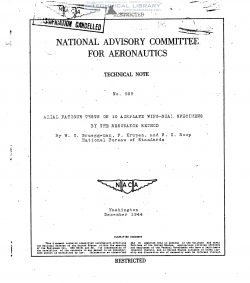naca-tn-959
- Version
- 127 Downloads
- 1.13 MB File Size
- 1 File Count
- December 1, 2016 Create Date
- December 1, 2016 Last Updated
National Advisory Committee for Aeronautics, Technical Notes - Axial Fatigue Tests of 10 Airplane Wing Beam Specimens by the Resonance Method

Axial fatigue tests have been made by the resonance
method on 10 specimens from airplane wing beams. The spec—
imens contained several types of stress raiser, such as
rivets. holes, fittings, splices, reinforcing plates, and
so forth. Some of the beams had been in flight service:
some had not. The method of obtaining resonant axial vibra—
tion and results for the first two wing beams already have
been reported in NAGA TN No. 660. Axial fatigue tests were
made, in addition. on coupon specimens machined from the
flanges. The tests were made in a direct tension—compression
fatigue machine using lubricated solid.guides to prevent
buckling. Some of the specimens were nominally free from
stress concentrations; others had a 0.1285~inch drilled hole
at midlength where the width was 3/8 inch. In addition,
coupon specimens consisting of.parallel strips of sheet metal
joined by idle rivets were tested.
The wing~beam specimens which had not been in service
were found to be stronger in fatigue than those which had.
All wing-beam specimens showed a much higher stress concen—
tration factor in fatigue than did the coupons containing
holes or idle rivets. It is believed that a web splice near
which failure occurred in most of the wing-beam specimens
accounts for this discrepancv by causing a damaging rtress
concentration.
In 1955 the National Bureau of Standards started an in—
vestigation at the request of the NASA to determine the
axial fatigue strength of airplane wing beams. The beams
were loaded by the resonance method in a manner similar to
that developed by the Goodyear Zeppelin Corporation (refer-
ence 1). Results.for the first two wing beams together with
details of the test method were reported in reference 2.
Eight more wing-beam specimens have since been tested, there—
by completing the program.
The purpose of the investigation was to determine the
effect on the fatigue strength of a full—size structure of
several important types of stress concentration and to deter—
mine whether it was practicable to design such a structure
on the basis of test results obtained on small, relatively
simple coupon specimens containing typical stress raisers.
| File | Action |
|---|---|
| naca-tn-959 Axial Fatigue Tests of 10 Airplane Wing Beam Specimens by the Resonance Method.pdf | Download |

Comment On This Post